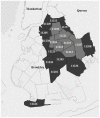Factors Associated with Recent HIV Testing among Heterosexuals at High Risk for HIV Infection in New York City
- PMID: 27200330
- PMCID: PMC4846660
- DOI: 10.3389/fpubh.2016.00076
Factors Associated with Recent HIV Testing among Heterosexuals at High Risk for HIV Infection in New York City
Abstract
Background: The Centers for Disease Control and Prevention recommends persons at high risk for HIV infection in the United States receive annual HIV testing to foster early HIV diagnosis and timely linkage to health care. Heterosexuals make up a significant proportion of incident HIV infections (>25%) but test for HIV less frequently than those in other risk categories. Yet factors that promote or impede annual HIV testing among heterosexuals are poorly understood. The present study examines individual/attitudinal-, social-, and structural-level factors associated with past-year HIV testing among heterosexuals at high risk for HIV.
Methods: Participants were African-American/Black and Hispanic heterosexual adults (N = 2307) residing in an urban area with both high poverty and HIV prevalence rates. Participants were recruited by respondent-driven sampling in 2012-2015 and completed a computerized structured assessment battery covering background factors, multi-level putative facilitators of HIV testing, and HIV testing history. Separate logistic regression analysis for males and females identified factors associated with past-year HIV testing.
Results: Participants were mostly male (58%), African-American/Black (75%), and 39 years old on average (SD = 12.06 years). Lifetime homelessness (54%) and incarceration (62%) were common. Half reported past-year HIV testing (50%) and 37% engaged in regular, annual HIV testing. Facilitators of HIV testing common to both genders included sexually transmitted infection (STI) testing or STI diagnosis, peer norms supporting HIV testing, and HIV testing access. Among women, access to general medical care and extreme poverty further predicted HIV testing, while recent drug use reduced the odds of past-year HIV testing. Among men, past-year HIV testing was also associated with lifetime incarceration and substance use treatment.
Conclusion: The present study identified gaps in rates of HIV testing among heterosexuals at high risk for HIV, and both common and gender-specific facilitators of HIV testing. Findings suggest a number of avenues for increasing HIV testing rates, including increasing the number and types of settings offering high-quality HIV testing; promoting STI as well as HIV testing; better integrating STI and HIV testing systems; implementing peer-driven social/behavioral intervention approaches to harness the positive influence of social networks and reduce unfavorable shared peer norms; and specialized approaches for women who use drugs.
Keywords: HIV screening; HIV testing; barriers to HIV testing; health disparities; heterosexuals; sex differences; structural barriers.
Figures
Similar articles
-
Exploring Factors Associated with Recent HIV Testing among Heterosexuals at High Risk for HIV Infection Recruited with Venue-based Sampling.J AIDS Clin Res. 2016 Feb;7(2):544. doi: 10.4172/2155-6113.1000544. Epub 2016 Feb 15. J AIDS Clin Res. 2016. PMID: 27104046 Free PMC article.
-
HIV Risk, prevention, and testing behaviors among heterosexuals at increased risk for HIV infection--National HIV Behavioral Surveillance System, 21 U.S. cities, 2010.MMWR Surveill Summ. 2014 Dec 19;63(14):1-39. MMWR Surveill Summ. 2014. PMID: 25522191
-
It's a Process: Reactions to HIV Diagnosis and Engagement in HIV Care among High-Risk Heterosexuals.Front Public Health. 2017 May 10;5:100. doi: 10.3389/fpubh.2017.00100. eCollection 2017. Front Public Health. 2017. PMID: 28540287 Free PMC article.
-
HIV infection and risk, prevention, and testing behaviors among injecting drug users -- National HIV Behavioral Surveillance System, 20 U.S. cities, 2009.MMWR Surveill Summ. 2014 Jul 4;63(6):1-51. MMWR Surveill Summ. 2014. PMID: 24990587
-
AIDS and heterosexual anal intercourse.Arch Sex Behav. 1991 Jun;20(3):233-76. doi: 10.1007/BF01541846. Arch Sex Behav. 1991. PMID: 2059146 Review.
Cited by
-
Syndemic Risk Classes and Substance Use Problems among Adults in High-Risk Urban Areas: A Latent Class Analysis.Front Public Health. 2017 Sep 7;5:237. doi: 10.3389/fpubh.2017.00237. eCollection 2017. Front Public Health. 2017. PMID: 28936431 Free PMC article.
-
"Like I Have No Choice": A Qualitative Exploration of HIV Diagnosis and Medical Care Experiences While Incarcerated and Their Effects.Behav Med. 2019 Apr-Jun;45(2):153-165. doi: 10.1080/08964289.2019.1591338. Behav Med. 2019. PMID: 31343965 Free PMC article.
-
Hepatitis C Co-infection in People Living With HIV-Epidemiologic Differences Between Men Who Have Sex With Men MSM and Non-MSM.Front Public Health. 2022 Jun 3;10:925600. doi: 10.3389/fpubh.2022.925600. eCollection 2022. Front Public Health. 2022. PMID: 35719672 Free PMC article.
-
Latent Classes of Sexual Risk Among Black Men Who Have Sex with Men and Women.Arch Sex Behav. 2018 Oct;47(7):2071-2080. doi: 10.1007/s10508-017-1142-y. Epub 2018 Mar 14. Arch Sex Behav. 2018. PMID: 29541914 Free PMC article.
-
HIV Prevention for Black Heterosexual Men: The Barbershop Talk with Brothers Cluster Randomized Trial.Am J Public Health. 2019 Aug;109(8):1131-1137. doi: 10.2105/AJPH.2019.305121. Epub 2019 Jun 20. Am J Public Health. 2019. PMID: 31219715 Free PMC article. Clinical Trial.
References
-
- Branson BM, Handsfield HH, Lampe MA, Janssen RS, Taylor AW, Lyss SB, et al. Revised recommendations for HIV testing of adults, adolescents, and pregnant women in health-care settings. MMWR Recomm Rep (2006) 55(RR-14):1–17. - PubMed
-
- Lansky A, Drake A, Pham HT. HIV-Associated behaviors among injecting-drug users-23 cities, United States, May 2005–February 2006. MMWR Morb Mortal Wkly Rep (2009) 58(50):1416–7. - PubMed
Grants and funding
LinkOut - more resources
Full Text Sources
Other Literature Sources
Miscellaneous


